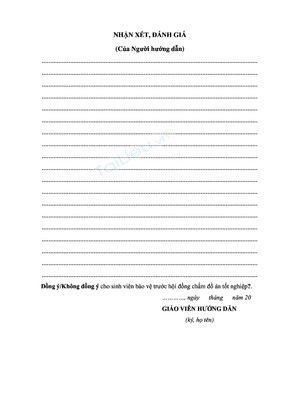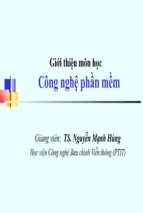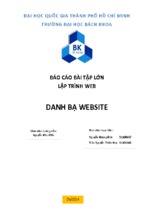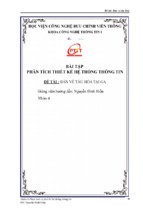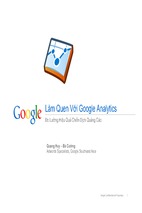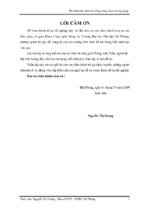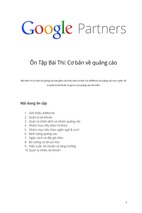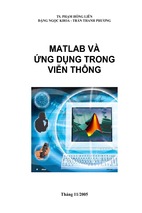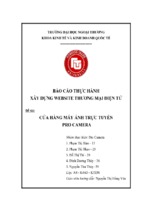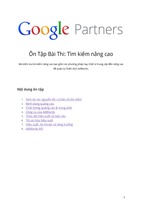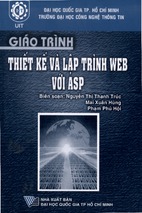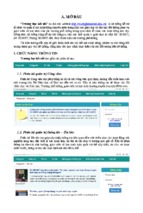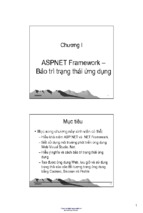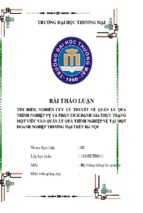TÀI LIỆU TẬP HUẤN GIẢNG VIÊN DẠY
CHUYÊN NGÀNH BẰNG TIẾNG ANH
KHOA: HÓA HỌC
MỤC LỤC
BÀI 1: KINH NGHIỆM XÂY DỰNG CHƯƠNG TRÌNH MÔN HÓA HỌC
BẰNG TIẾNG ANH.......................................................................................................... 2
BÀI 2: MATTER AND CLASSIFICATION OF MATTER .................................. 4
BÀI 3: ELEMENTS AND PERIODIC TABLE ...................................................... 12
BÀI 4: THE ALKALI METALS.................................................................................. 23
BÀI 5: ANKANES ........................................................................................................... 32
1
Tài liệu tập huấn giảng viên dạy chuyên ngành bằng tiếng Anh
BÀI 1: KINH NGHIỆM XÂY DỰNG CHƯƠNG TRÌNH MÔN HÓA HỌC
BẰNG TIẾNG ANH
1.1 Cơ sở lý thuyết
Chương trình chi tiết giáo dục đại học ngành Sư phạm Hóa học dạy bằng
tiếng Anh được xây dựng trên cơ sở chương trình khung giáo dục đại học
ngành Sư phạm Hóa học trình độ đại học, ban hành theo quyết định số
2682/QĐ – ĐHSP HN, ngày 21 tháng 9 năm 2009 của Hiệu trưởng trường
Đại học Sư phạm Hà Nội.
Chương trình chi tiết giáo dục đại học ngành Sư phạm Hóa học bằng tiếng
Anh được xây dựng trên cơ sở kế thừa bề dày truyền thống gần 64 năm đào
tạo giáo viên của khoa Hóa học, trường Đại học Sư phạm Hà Nội, kết hợp
với nguyên tắc đảm bảo tính hiện đại, tính hiệu quả, tính hệ thống và tính
phát triển, tính thực tiễn và mềm dẻo. Trên cơ sở đó, chương trình phát triển
phù hợp với các yêu cầu và đòi hỏi ngày càng cao của đời sống xã hội, về sự
hòa nhập quốc tế và khu vực, thực hiện tốt hơn nhiệm vụ đào tạo giáo viên
giảng dạy Hóa học ở các trường THPT. Chương trình đào tạo nhằm đào tạo
đội ngũ giáo viên có năng lực chuyên môn, nghiệp vụ chất lượng cao, có
khả năng giảng dạy Hóa học ở phố thông bằng tiếng Anh, thể hiện được đổi
mới về nội dung và phương pháp đào tạo theo hướng cập nhật với quốc tế,
đồng thời phù hợp với điều kiện của Việt Nam.
Chương trình chi tiết giáo dục đại học ngành Sư phạm Hóa học dạy bằng
tiếng Anh được xây dựng đáp ứng yêu cầu của chuẩn đầu ra là đào tạo cán
bộ có đủ năng lực làm giáo viên dạy học Hóa học cấp học trung học cơ sở,
trung học phổ thông bằng tiếng Anh. Có ý chí vươn lên và có đủ khả năng
tiếp tục học tập để trở thành giáo viên các trường trung học chuyên nghiệp,
trường cao đẳng và đại học; cán bộ nghiên cứu tại các trung tâm nghiên
cứu khoa học, viện nghiên cứu, cơ sở sản xuất thuộc ngành Hóa học, Môi
trường, cơ sở sản xuất kinh doanh có liên quan đến lĩnh vực Hóa học. Sinh
viên tốt nghiệp ngành Sư phạm Hóa học có đủ khả năng tiếp tục học tập và
nghiên cứu chuyên môn ở trình độ thạc sỹ và tiến sỹ hóa học, cũng như có
đủ khả năng để có thể xin được các học bổng của nước ngoài.
2
Tài liệu tập huấn giảng viên dạy chuyên ngành bằng tiếng Anh
1.2 Tiến trình xây dựng:
-
Xây dựng chương trình đào tạo cử nhân sư phạm Hóa dạy bằng tiếng
Anh.
-
Xây dựng khung trương trình chi tiết
-
Xây dựng bài giảng bằng tiếng Anh
Tiến hành dạy mẫu, rút kinh nghiệm
Chỉnh sửa tài liệu
-
Nghiệm thu chương trình và tài liệu giảng dạy Hóa học bằng tiếng Anh
-
Tiến hành dạy cho sinh viên khoa Hóa học
-
Hàng năm có tổ chức rút kinh nghiệm, chỉnh sửa chương trình, đề
cương chi tiết cũng như bài giảng cho hoàn thiện.
3
Tài liệu tập huấn giảng viên dạy chuyên ngành bằng tiếng Anh
BÀI 2: MATTER AND CLASSIFICATION OF MATTER
Vocabulary
Matter
Component
Pure substance
Proportion
Element
Uniform
Compound
Atom
Mixture
Molecule
Homogeneous
Combination
Heterogeneous
Properties
Composition
Dictionary definitions of chemistry usually include the terms matter,
composition, and properties, as in the statement that “chemistry is the science
that deals with the composition and properties of various forms of matter”.
Matter is anything that occupies the space and displays a property
known as mass. Every human being is an object of matter. We all occupy
space, and we describe our mass though a related property, our weight. All
the objects that we see around us are objects of matter. The gases of the
atmosphere, even though they are invisible, are example of matter; they
occupy space and possess mass.
Composition refers to the parts of components of a sample of matter
and their relative proportions. Ordinary water is comprised of two simpler
substances – hydrogen and oxygen – present in certain fixed proportions.
Properties are those qualities or attributes that can be used to
distinguish one sample of matter form others.
Matter is classified into two broad categories, namely, pure substances
and mixtures. A pure substance can be either an element or a compound. The
composition and properties of an element or compound are uniform
4
Tài liệu tập huấn giảng viên dạy chuyên ngành bằng tiếng Anh
throughout a given sample and from one sample to another. A chemical
element is a substance comprised of a single type of atom. The elements are
the building blocks of our nature. An element is either discovered in nature or
synthesized in the laboratory in pure form that cannot be separated into
simpler substances by chemical methods. Currently, there are about 118
elements discovered; some are found to be unique; no two elements are alike.
Elements are made up of tiny particles called atoms. Atoms are the smallest
particles of an element that have the chemical properties of that element. Each
element contains only one type of atoms. The atoms of one element are not the
same as the atoms of another element. Most of the elements exist as
monoatomic forms, which means that the smallest individual complete parts of
these samples of pure elements are single atoms. Seven of the known elements
are called diatomic elements, because they are found in nature in their
elemental form as two-atom molecules. The seven diatomic elements are
chlorine (Cl2), fluorine (F2), bromine (Br2), iodine (I2), hydrogen (H2), oxygen
(O2), and nitrogen (N2).
A compound is the substance formed by the chemical union of two or
more element. The number of compounds now known is in the millions. In
some cases we can isolate a molecule of a compound. A molecule is the
smallest entity having the same proportions of the constituent atoms as does
the compound as a whole. A molecule of water consists of three atoms – two
hydrogen atoms joined to a single oxygen atom. Components of the
compounds are in a definite ratio, which is fixed by the nature. We cannot
change this ratio, no matter who does it. For example, water is made up of one
part oxygen and two parts hydrogen. This ratio is fixed by the nature and we
cannot alter this. Compounds are formed by chemical reactions, where the
individual elements lose their individual properties and take on the new
properties of the compound that is formed. Compounds can be separated into
elements using chemical methods but not the physical methods.
A mixture is a physical combination of two or more substances where
the substances retain their original identity. Some examples are air, milk,
various fruit drinks. The most important aspect of the mixture is that it has no
definite or constant composition, Mixtures can be separated into pure
5
Tài liệu tập huấn giảng viên dạy chuyên ngành bằng tiếng Anh
substances by physical methods. Mixture is further classified as either
homogeneous or heterogeneous based upon its uniformity.
A homogeneous mixture is a solution that has a uniform consistency
throughout, for example, a salt solution after dissolving and mixing it
thoroughly. Not only that but also the individual components cannot be
identified. A heterogeneous mixture does not have uniform composition like
homogeneous mixture where the individual components can be identified, for
example, a mixture of sand and salt.
The scheme that classified matter into elements, compounds and
mixtures is summarized in figure 1.
Figure 1. A classification scheme for matter
I.
Comprehension questions
1. What is chemistry?
Chemistry is the science that deals with the composition and
properties of various forms of matter.
2. Why is water an object of matter?
Because water occupies space and has mass.
3. What is water made up of?
Water is made up of hydrogen and oxygen.
4. What is the difference between an element and a compound?
6
Tài liệu tập huấn giảng viên dạy chuyên ngành bằng tiếng Anh
An element is a substance composed of a single type of atom while a
compound is the substance formed by two or more element chemically
combined.
5. What is a molecule defined as?
A molecule is the smallest entity having the same proportions of the
constituent atoms as does the compound as a whole.
6. What is the difference between homogeneous and heterogeneous
mixtures?
A homogeneous mixture has a uniform consistency throughout while
a heterogeneous mixture does not have uniform composition.
7. Which kind of matter has uniform composition?
Pure substance has uniform composition.
8. What are the building blocks of the elements?
The building blocks of the elements are the atoms.
9. Why is chlorine called a diatomic element?
Because chlorine contains two atoms in its molecules.
10. Which kind of matter can be separated by physical methods?
Mixture can be separated into substances by physical methods.
II.
No
True (T) or false (F) or not mentioned (N) statements
T/F/N Statements
1.
A substance is a type of matter that has a consistent composition.
2.
Elements are substances that are made up of two or more elements
chemically combined.
3.
Whereas a compound is made from the chemical combination of two
or more substances, a mixture is made from two or more substances
that are physically combined.
4.
Heterogeneous mixtures are mixtures that have a consistent, or
uniform composition throughout the entire sample.
5.
Unlike in the example of compounds, the substances that make up a
7
Tài liệu tập huấn giảng viên dạy chuyên ngành bằng tiếng Anh
mixture do not lose their individual properties.
The individual substances in a mixture do not lose their original
properties, and the substances in a mixture can be separated by
6.
physical means.
7.
When the compound is formed, altogether a new substance is formed
and the properties of which are similar to its constituent elements.
8.
All mixtures have a variable composition, it means that the
substances that are found in the mixture can be mixed in with
varying proportion or concentrations.
9.
Chemical reactions can break more complex substances down into
elements, but elements can only be broken down further by nuclear
reactions.
10.
Oxygen is a substance because it has a consistent composition and it
is an element because it is only made up of one type of atom.
III.
Translation
Translation 1
1. Các nguyên tố có thể được phân loại thành hai nhóm chính – kim loại
và phi kim.
Elements can be classified into two major groups – metals and nonmetals.
2. Phân tử là nhóm gồm hai hay nhiều hơn các nguyên tử mà liên kết một
cách hóa học với nhau.
A molecule is a group of two or more atoms that are chemically
combined.
3. Hợp chất được tạo bởi các nguyên tố khác nhau liên kết một cách hóa
học với nhau theo một tỉ lệ xác định.
A compound is made up of different elements chemically combined in a
fixed ratio.
8
Tài liệu tập huấn giảng viên dạy chuyên ngành bằng tiếng Anh
4. Các ion tích điện dương được hình thành khi một nguyên tử mất đi
electron.
A positively charged ion is formed when an atom loses electrons.
5. Nhiệt có thể được sử dụng để phá vỡ hợp chất thành các hợp chất đơn
giản hơn hoặc là các nguyên tố.
Heat can be used to break down compounds into elements or simpler
compounds.
6. Các thành phần của hỗn hợp có thể trộn lẫn với nhau theo một tỷ lệ bất
kỳ.
The components of a mixture can be mixed in any proportion.
7. Một số chất nguyên chất, giống như bạc, chỉ chứa một loại chất.
Some substances, like silver, contain only one kind of matter.
8. Hỗn hợp đồng thể của chất tan và dung môi được gọi là dung dịch.
A homogeneous mixture of solute and solvent are called solutions.
9. Các dạng đơn giản của chất mà không thể phân hủy thành các chất đơn
giản hơn được gọi là các nguyên tố.
Simple forms of matter which cannot be decomposed into further simple
substances are called elements.
10. Hợp chất của sắt và lưu huỳnh là sắt sunfua.
A compound of iron and sulfur is iron sulf ide.
Translation 2
1. Petroleum is a very complex mixture that we extract from the Earth.
Xăng dầu là một hỗn hợp rất phức tạp mà chúng ta có thể chiết xuất từ
Trái Đất.
2. Colloids are the heterogeneous mixture of two or more components
with the size of the particle is 1nm to 100nm.
Các chất keo là hỗn hợp dị thể của hai hay nhiều các thành tố với kích
thước hạt từ 1nm đến 100nm.
3. A mixture of two components that appears in a single phase is called a
homogeneous mixture.
Một hỗn hợp của hai thành tố tồn tại ở một pha được gọi là hỗn hợp
đồng thể.
9
Tài liệu tập huấn giảng viên dạy chuyên ngành bằng tiếng Anh
4. The amount of a solute present in a unit volume of the solution is called
concentration of the solution.
Lượng chất tan tồn tại trong một đơn vị thể tích của dung dịch được gọi
là nồng độ của dung dịch.
5. Chalk contains calcium, carbon, and oxygen in the proportion of one
atom each of calcium and carbon to three atoms of oxygen.
Phấn chứa canxi, cacbon và oxi theo tỉ lệ một nguyên tử canxi và
cacbon với ba nguyên tử oxi.
6. Alloys are usually made to improve on the properties of the elements
that make them up.
Cách hợp kim thường được tạo ra với mục đích làm tăng các tính chất
của các nguyên tố tạo nên chúng.
7. An important characteristic of a compound is that it has a chemical
formula, which describes the ratio in which the atoms of each element
in the compound occur.
Một đặc tính quan trọng của hợp chất là chúng có công thức hóa học
mô tả tỉ lệ các nguyên tử của mỗi nguyên tố tham gia trong hợp chất.
8. Elemental symbols are the abbreviated notations for elements
consisting of one or two letters.
Kí hiệu nguyên tố là dạng kí hiệu viết tắt của các nguyên tố bao gồm
một hoặc hai chữ cái.
9. The weight is a measure of the gravitational force exerted on an object.
Trọng lượng được đo bằng lực trọng trường tác dụng lên vật.
10. A phase is a region of matter that possesses uniform intensive
properties throughout its volume.
Pha là vùng của chất có các tính chất cường độ đồng nhất trong toàn
bộ thể tích của chúng.
IV.
Further reading
The states of matter
Matter can exist in three different states, solid, liquid, and gas, based on
the way the atoms and molecules are arranged inside them. These three states
are known as three different states of matter.
10
Tài liệu tập huấn giảng viên dạy chuyên ngành bằng tiếng Anh
In solids, atoms or molecules are tightly bound to one another thereby
creating a rigid nature. Each atom or molecule is caged by its neighbors
creating non-mobility, although they might vibrate around the equilibrium
position. Here attractive forces are very strong. Consequently, solids have
definite shapes and volumes. Some examples of solids are diamond, metals,
and ice.
In liquids, the atoms or molecules are not as tightly bound as in solids
and due to that they have some freedom to move around. They still experience
attractive forces but not as strong as solids. In addition, they also begin to
experience some repulsive forces. Thus, liquids have definite volume but not
definite shape- they assume the shape of the container. Due to their flexibility,
the liquids can be poured from one container to another. Some common
examples are water, gasoline, and alcohol at room temperature.
In gases, the atoms or molecules are far apart due to they are not
bounded at all, meaning, they do not have any attractive forces but only
repulsive forces. Due to that they can occupy a large volume. They do not
have their own shape or volume, but assume the shape and the volume of the
container. Some common examples are oxygen, hydrogen, and helium at room
temperature.
11
Tài liệu tập huấn giảng viên dạy chuyên ngành bằng tiếng Anh
BÀI 3: ELEMENTS AND PERIODIC TABLE
Vocabulary
Oxidation number
Principle
Atom
Quantum number
Atomic orbitals
Relative pronouns
Azimuthal quantum number
Rule
Electron configuration
Wave function
Electron state
Solvent
Magnetic quantum number
Confusion
Metallic character
Determine
I. Reading comprehension
Periodic table
The idea of arranging the elements into a periodic table had been
considered by many chemists, but either data to support the idea were
insufficient or the classification schemes were incomplete. Mendeleev and
Meyer organized the elements in order of atomic weight and then identified
groups of elements with similar properties. By arranging these groups in rows
and columns, and by considering similarities in chemical behavior as well as
atomic weight, Mendeleev found vacancies in the table and was able to predict
the properties of several elements—gallium, scandium, germanium, and
polonium—that had not yet been discovered. When his predictions proved
accurate, the concept of a periodic table was quickly accepted. The discovery
of additional elements not known in Mendeleev’s time and the synthesis of
heavy elements have led to the modern periodic table, shown inside the front
cover of this text. In the modern periodic table, a horizontal row of elements is
called a period and a vertical column is a group. The traditional designations
12
Tài liệu tập huấn giảng viên dạy chuyên ngành bằng tiếng Anh
of groups in the United States differ from those used in Europe. The
International Union of Pure and Applied Chemistry (IUPAC) has
recommended that the groups be numbered 1 through 18. In this text, we will
use primarily the IUPAC group numbers. Some sections of the periodic table
have traditional names, as shown in Figure 1.
Starting from hydrogen, over 100 elements are constituted as electrons
are successively accommodated into 1s, 2s, 2p, 3s, 3p, 4s, and 3d orbitals one
by one from lower to higher energy levels. When elements with similar
properties are arranged in columns, the periodic table of the elements is
constructed. The modern periodic table of the elements is based on one
published by D. I. Mendeleev in 1892, and a variety of tables have since been
devised. The long periodic table recommended by IUPAC is the current
standard, and it has the group numbers arranged from Group 1 alkali metals
through group 18 rare gas elements. Based on the composition of electron
orbitals, hydrogen, helium and Group 1 elements are classified as s-block
elements, Group 13 through Group 18 elements p-block elements, Group 3
through Group 12 elements d-block elements, and lanthanoid and actinoid
elements f-block elements. (Fig. 1). s-Block, p-block, and Group 12 elements
are called main group elements and d-block elements other than Group 12
and f-block elements are called transition elements. Incidentally, periodic
tables that denote the groups of s-block and p-block elements with Roman
numerals (I, II, ..., VIII) are still used, but they will be unified into the IUPAC
system in the near future. Since inorganic chemistry covers the chemistry of
all the elements, it is important to understand the features of each element
though reference to the periodic table.
13
Tài liệu tập huấn giảng viên dạy chuyên ngành bằng tiếng Anh
d-block
p-block
s-block
f-block
Figure 1 Periodic table
I.1. Question:
1. How did Mendeleev and Meyer organize the elements?
Mendeleev and Meyer organized the elements in order of atomic weight and
then identified groups of elements with similar properties.
2. What is the best advantage of Mendeleev’s organization of element?
Mendeleev found vacancies in the table and was able to predict the properties
of several elements—gallium, scandium, germanium, and polonium—that had
not yet been discovered
3. What are names of horizontal row and vertical column of elements
called in a modern periodic table?
The horizontal row of elements is called a period and a vertical column is a
group.
4. How electrons are filled up in the first 100 elements in the periodic
table?
14
Tài liệu tập huấn giảng viên dạy chuyên ngành bằng tiếng Anh
These electrons are successively accommodated into 1s, 2s, 2p, 3s, 3p, 4s, and
3d orbitals one by one from lower to higher energy levels
5. How does IUPAC recommend for group numbering?
It has recommended that the groups be numbered 1 through 18.
6. What is general name of elements if the Group 18?
It is the rare gas.
7. Which elements are classified as the s-block elements?
Hydrogen, helium and Group 1 elements
8. What is another name of d-block elements?
They are called transition elements.
9. What are main group elements?
s-Block, p-block, and Group 12 elements are called main group elements.
10. What is the necessary ideal to learn about periodic table?
The periodic table helps us to predict the features of each element.
I.2. True (T), false (F) or doesn’t say (DS)
11
Arrangement of elements is based on considering similarities in
chemical behavior.
12
IUPAC has suggested using Roman number for labeling groups.
13
All elements are constructed by electrons that accommodate 1s,
2s, 2p, 3s, 3p, 4s, and 3d orbitals.
14
15
15
There is no change in chemical properties of elements following
a period.
The discovery of additional elements not known in Mendeleev’s
time.
Tài liệu tập huấn giảng viên dạy chuyên ngành bằng tiếng Anh
16
f-Block elements are only called transition elements.
17
18
19
The d-block corresponds to the transition metals.
20
Blocks are sometimes called families.
A variety of tables have since been invented at the same time
with D. I. Mendeleev’s periodic table.
Mayer had recommended that the groups be numbered 1 through
18.
I.3. Fill in blank
number
ionization
properties
trend
character
become
acidic
non-metal
basic
across
group
properties
carbonate
silicon
basic
CHEMICAL CHARACTER
In any (21) …………of the periodic table we have already noted that
the 22)…………… of electrons in the outermost shell is the same for each
element and the (23)…………… energy falls as the group is descended. This
immediately predicts two likely (24)……… … ……. of the elements in a
group. The first property is their general similarity. Another one is the
(25)…………… towards metallic behavior as the group is descended. We
shall see that these predicted (26)……………… are borne out when we study
the individual groups. Increasing metallic electropositive behavior down a
group also implies a change in the (27)……….. of the oxides. They will be
expected to (28)……………. more basic as we descend the group and a
change from an (29)…………. oxide, i.e. an oxide of a (30)…………. which
readily reacts with OH~ or oxide ions to give oxo acid anions , to a
16
Tài liệu tập huấn giảng viên dạy chuyên ngành bằng tiếng Anh
(31)……………. oxide, i.e. one which readily yields cations, in some groups.
The best example of such a change is shown by the Group IV elements; the
oxides of carbon and (32)……………. are acidic, readily forming
(33)……………… and silicate anions, whilst those of tin and lead are
(34)……………. giving such ions as Sn2+ and Pb2+ in acidic solution. Metallic
character diminishes (35) ………….. a period and in consequence the oxides
become more acidic as we cross a given period. This is clearly demonstrated
in Period 3.
II. Grammar
THE ADJECTIVE CLAUSE
An adjective clause is a subordinate clause used to modify a noun or a
pronoun in the main clause. It may be introduced by the pronouns who,
whose, whom, which, or that (and sometimes when or where). These
pronouns are called relative pronouns because they relate to a noun or a
pronoun in the sentence. Occasionally, no relative pronoun is used, but it is
implied or understood.
Identifying Adjective Clauses
Note: Nouns are bolded, the adjective clauses are underlined.
1. Mike, whose ancestors came from Ireland, marched in the St. Patrick's Day
parade.
2. The woman who lives next door is a registered nurse.
3. Williamsburg, Virginia, is a place that I'd like to visit
4. Math, which is Dave's favorite subject, has always been easy for him.
5. There is the house that I'd like to buy.
6. Larry's letter, which he mailed Tuesday, reached me on Thursday.
7. Summer, which is my favorite season, will be here in another week.
8. Phil is reading The Call of the Wild, which is Jack London's most famous
book.
17
Tài liệu tập huấn giảng viên dạy chuyên ngành bằng tiếng Anh
9. We live just twenty miles from O'Hare Airport, which is the world's
busiest airport.
10 Newton, Iowa, is the town where Barbara was born.
11. I'm taking golf lessons from Erika Lavery, who is a pro at the country
club.
12. That dog that you found belongs to the Olsons.
13. Is that the jacket you want to buy?
14. There is a chance that Norm will win the election.
15. Is this the letter you were expecting?
16. Over there is the school that I attended.
17. Mr. Hartman is a history teacher who also coaches track.
18. Is that the antique show you visited?
19. The Harveys have a dog that is fourteen years old.
20. For dinner, we had chicken fried steak, which is my favorite dish.
Exercise
36. Mendeleev had no idea what atoms were made of or why they behaved as
they did.
37. Electronegativity is one of the most fundamental atomic parameters
which express numerically the tendency to attract electrons to atoms in a
molecule.
38. The Pauling scale, which was introduced first in 1932, is still the most
frequently used.
39. Those elements which are hard to ionize and easy to attract electrons have
large values
40. In the formation of a molecule, atomic orbitals overlap to generate a
molecular orbital which is the wave function of the electrons in the
molecule.
18
Tài liệu tập huấn giảng viên dạy chuyên ngành bằng tiếng Anh
41. The Group 6 to 10 transition metals that do not form binary hydrides give
many hydride complexes with auxiliary ligands such as carbonyl and
tertiaryphosphines.
42. Most of this silicon exists as a component of silicate rocks that is not found
as a simple substance.
43. Oxygen, which is one of the most important gases for animals, is about
20% in atmosphere.
44. It is impossible to find potassium metal in nature where potassium can
with water… to form potassium cation.
45. s-Block elements have sodium element, which is a alkaline metal.
46. Beaker is the most popular glassware that is used in chemistry laboratory.
47. Halogens that are strongly oxidative elements are located in the group VII.
48. Sodium chloride that is easily dissolved in water causes the high pressure
disease.
49. Higher-grade silicon is obtained by hydrogen reduction of SiHCl , which
3
is produced by the hydrochlorination of low purity silicon followed by
rectification.
50. Silicates and organosilicon compounds that are shown a wide range of
structures in silicon chemistry can be synthesized in laboratory.
III. Translation
III.1 Translate into Vietnamese
51. In 1884, Arrhenius defined that an acid is a substance that gives H+ and a
base one that gives OH-.
52. Namely, if an acid is HA and a base BOH, then HAH+ + A- and BOH
B+ + OH-.
53. Therefore, when an acid and a base react, water is formed.
19
Tài liệu tập huấn giảng viên dạy chuyên ngành bằng tiếng Anh
- Xem thêm -

